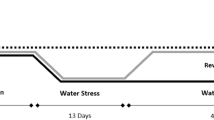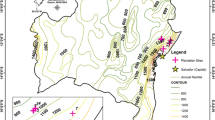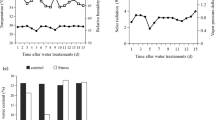Abstract
Water stress is considered one of the main environmental factors that limit survival and productivity of Eucalyptus plantations. Identifying genotypes traits that provide evidence of tolerance to water stress may allow sustained productivity and secure better resilience of forest plantations under climate change in Mediterranean environments. Our study analyzed morphological, physiological, and carbon (C) balance responses of ten Eucalyptus genotypes under contrasting water regimes under nursery conditions. One-year-old cuttings of Eucalyptus nitens (En1 and En2), E. smithii (Es), E. badjensis (Eb), E. nitens x globulus (Eng1, Eng2, Eng3, and Eng4), E. globulus (Eg), and E. camaldulensis x globulus (Ecg) were evaluated under progressive drought from well-watered (soil water potential close to 0 MPa) to severe water stress (soil water potential close to − 2.5 MPa) conditions. Absolute growth rate (root collar diameter, height, shoot: root biomass ratio), net photosynthesis, stomatal conductance, transpiration, intrinsic water use efficiency (iWUE), predawn water potential (Ψpd) and C balance (flux and partitioning) were evaluated. As expected, water stress significantly reduced growth and physiological activity for all genotypes. Of all evaluated parameters iWUE and Ψpd were the key grou** physiological and growth response variables among genotypes. Genotypes En1, Eng3, and Eng4 were considered tolerant genotypes, with the smallest physiological change and larger morphological growth. Genotypes En2, Es, Eng1 and Eng2 were moderately tolerant showing intermediate responses compared to other groups. In contrast, Eg, Eb, and Ecg were considered highly sensitive, with major changes in morphology and physiological variables over time. Our results suggest that nursery stage physiological evaluation of genotypes may allow selection for sites with water resource availability risks and may allow to reduce mortality and early establishment productivity losses under drier climate change scenarios.




Similar content being viewed by others
References
Amrutha S, Parveen ABM, Muthupandi M, Sivakumar V, Nautiyal R, Dasgupta MG (2019) Variation in morpho-physiological, biochemical and molecular responses of two Eucalyptus species under short-term water stress. Acta Bot Croat 78:125–134
Aspinwall MJ, Drake JE, Campany C, Vårhammar A, Ghannoum O, Tissue DT, Reich PB, Tjoelker MG (2016) Convergent acclimation of leaf photosynthesis and respiration to prevailing ambient temperatures under current and warmer climates in Eucalyptus tereticornis. New Phytol 212:354–367
Bahuguna RN, Jagadish KS (2015) Temperature regulation of plant phenological development. Environ Exp Bot 111:83–90
Beltrame R, Bisognin DA, Mattos BD, Cargnelutti Filho A, Haselein CR, Gatto DA, Santos GAd (2012) Silvicultural performance and early selection of clones from Eucalyptus hybrids. Pesq Agrop Brasileira 47:791–796
Booth TH (2013) Eucalypt plantations and climate change. For Ecol Manage 301:28–34
Boreham G, Pallett R (2009) The influence of tree improvement and cultural practices on the productivity of Eucalyptus plantations in temperate South Africa. South for: a J for Sci 71:85–93
Campoe OC, Stape JL, Laclau J-P, Marsden C, Nouvellon Y (2012) Stand-level patterns of carbon fluxes and partitioning in a Eucalyptus grandis plantation across a gradient of productivity, in Sao Paulo State, Brazil. Tree Physiol 32:696–706
Campoe OC, Alvares CA, Carneiro RL, Binkley D, Ryan MG, Hubbard RM, Stahl J, Moreira G, Moraes LF, Stape JL (2020) Climate and genotype influences on carbon fluxes and partitioning in Eucalyptus plantations. For Ecol Manage 475:118445
Chaves MM, Maroco JP, Pereira JS (2003) Understanding plant responses to drought—from genes to the whole plant. Funct Plant Biol 30:239–264
Chaves MM, Flexas J, Pinheiro C (2009) Photosynthesis under drought and salt stress: Regulation mechanisms from whole plant to cell. Ann Bot 103:551–560
Chen X, Zhao P, Ouyang L, Zhu L, Ni G, Schäfer KV (2020) Whole-plant water hydraulic integrity to predict drought-induced Eucalyptus urophylla mortality under drought stress. For Ecol Manage 468:118179
Coopman RE, Jara JC, Bravo LA, Sáez KL, Mella GR, Escobar R (2008a) Changes in morpho-physiological attributes of Eucalyptus globulus plants in response to different drought hardening treatments. Electron J Biotechnol 11(2):30–39
Coopman RE, Jara JC, Bravo LA, Sáez KL, Mella GR, Escobar R (2008b) Changes in morpho-physiological attributes of Eucalyptus globulus plants in response to different drought hardening treatments. Electron J Biotechnol 11:30–39
Corrêa TR, de Toledo Picoli EA, de Souza GA, Conde SA, Silva NM, Lopes-Mattos KLB, de Resende MDV, Zauza EAV, Oda S (2017) Phenotypic markers in early selection for tolerance to dieback in Eucalyptus. Ind Crops Prod 107:130–138
de Toledo Picoli EA, de Resende MDV, Oda S (2021) Come hell or high water: breeding the profile of Eucalyptus tolerance to abiotic stress focusing water deficit. Plant Growth Stress Physiol. https://doi.org/10.1007/978-3-030-78420-1_5
Duan H, Amthor JS, Duursma RA, O’Grady AP, Choat B, Tissue DT (2013) Carbon dynamics of eucalypt seedlings exposed to progressive drought in elevated [CO2] and elevated temperature. Tree Physiol 33:779–792
Eilmann B, Rigling A (2012) Tree-growth analyses to estimate tree species drought tolerance. Tree Physiol 32:178–187
El- Sharkawy M (2014) Global warming: causes and impacts on agroecisistems productivity and food security with emphasis on cassava competitive advantage in the tropics/subtropics A. R.–1 Institute of experimental botany, Ed.) Photosynthetica. Int J Photosynth Res 52(2):161–178
Elli EF, Sentelhas PC, Bender FD (2020) Impacts and uncertainties of climate change projections on Eucalyptus plantations productivity across Brazil. For Ecol Manage 474:118365
Epron D, Nouvellon Y, Ryan MG (2012) Introduction to the invited issue on carbon allocation of trees and forests. Tree Physiol 32:639–643
Erice G, Louahlia S, Irigoyen JJ, Sanchez-Diaz M, Avice JC (2010) Biomass partitioning, morphology and water status of four alfalfa genotypes submitted to progressive drought and subsequent recovery. J Plant Physiol 167:114–120
Fagundes FFA, da Silva Reis FY, Martins FB (2021) A model for predicting the initial development of two native forest species under current and future climates. Environ Exp Bot 192:104662
Flexas J, Ribas-Carbó M, Diaz-Espejo A, Galmés J, Medrano H (2008) Mesophyll conductance to CO2: current knowledge and future prospects. Plant, Cell Environ 31:602–621
Florêncio GWL, Martins FB, Fagundes FFA (2022) Climate change on Eucalyptus plantations and adaptive measures for sustainable forestry development across Brazil. Ind Crops Prod 188:115538
Forrester D, Collopy J, Morris J (2010) Transpiration along an age series of Eucalyptus globulus plantations in southeastern Australia. For Ecol Manage 259(1754):1760
Giardina CP, Ryan MG (2002) Total belowground carbon allocation in a fast-growing Eucalyptus plantation estimated using a carbon balance approach. Ecosyst 5:487–499
Giardina CP, Ryan MG, Binkley D, Fownes JH (2003) Primary production and carbon allocation in relation to nutrient supply in a tropical experimental forest. Glob Change Biol 9:1438–1450
Gonçalves JLDM, Alvares CA, Higa AR, Silva LD, Alfenas AC, Stahl J, Ferraz SFDB, Lima WDP, Brancalion PHS, Hubner A, Bouillet JPD, Laclau JP, Nouvellon Y, Epron D (2013) Integrating genetic and silvicultural strategies to minimize abiotic and biotic constraints in Brazilian eucalypt plantations. For Ecol Manage 301:6–27
Gonçalves JL, Alvares CA, Rocha JH, Brandani CB, Hakamada R (2017) Eucalypt plantation management in regions with water stress. South for: J for Sci 79:169–183
Hakamada R, Hubbard RM, Ferraz S, Stape JL, Lemos C (2017) Biomass production and potential water stress increase with planting density in four highly productive clonal Eucalyptus genotypes. South for: J for Sci 79:251–257
Hodecker BER, Pita-Barbosa A, de Barros NF, Merchant A (2018) Water availability preceding long-term drought defines the tolerance of Eucalyptus to water restriction. New for 49:173–195
Hubbard RM, Stape J, Ryan MG, Almeida AC, Rojas J (2010) Effects of irrigation on water use and water use efficiency in two fast growing Eucalyptus plantations. For Ecol Manage 259:1714–1721
INFOR (2020) Anuario Forestal 2020. Chilean Statistical Yearbook Of Forestry 2020. Boletín Estadístico/Statistical Bulletin N° 174.
Lucani CJ, Brodribb TJ, Jordan G, Mitchell PJ (2018) Intraspecific variation in drought susceptibility in Eucalyptus globulus is linked to differences in leaf vulnerability. Funct Plant Biol 46:286–293
Ma F, Xu TT, Ji MF, Zhao CM (2014) Differential drought tolerance in tree populations from contrasting elevations. AoB PLANTS 6
Madhibha T, Murepa R, Musokonyi C, Gapare W (2013) Genetic parameter estimates for interspecific Eucalyptus hybrids and implications for hybrid breeding strategy. New for 44:63–84
Martins FB, Benassi RB, Torres RR, de Brito Neto FA (2022) Impacts of 1.5 C and 2 C global warming on Eucalyptus plantations in South America. Sci Total Environ 825:153820
Maseda PH, Fernández RJ (2016) Growth potential limits drought morphological plasticity in seedlings from six Eucalyptus provenances. Tree Physiol 36:243–251
Matusick G, Ruthrof KX, Fontaine JB, Hardy GESJ (2016) Eucalyptus forest shows low structural resistance and resilience to climate change-type drought. J Veg Sci 27:493–503
McDowell N, Pockman WT, Allen CD, Breshears DD, Cobb N, Kolb T, Plaut J, Sperry J, West A, Williams DG (2008) Mechanisms of plant survival and mortality during drought: why do some plants survive while others succumb to drought? New Phytol 178:719–739
Mokotedi ME (2010) Physiological responses of Eucalyptus nitens× nitens under experimentally imposed water stress. South for 72:63–68
Mueller C, Hodecker BER, De Barros NF, & Merchant A (2020) A physiological approach for preselection of eucalyptus clones resistant to drought. iFor Biogeosci For, 13(1): 16.
Nóia Júnior RdS, Amaral GC, Pezzopane JEM, Fonseca MDS, Câmara da Silva AP, Xavier TMT (2020) Ecophysiological acclimatization to cyclic water stress in Eucalyptus. J for Res 31:797–806
Pita-Barbosa A, Oliveira LA, de Barros NF, Hodecker BER, Oliveira FS, Araújo WL, Martins SC (2023) Develo** a Roadmap to Define a Potential Ideotype for Drought Tolerance in Eucalyptus. For Sci 69:101–114
Pommerening A, Muszta A (2015) Methods of modelling relative growth rate. For Ecosyst 2:5
Rodrigues GG, Silva LD, Nouvellon Y (2021) Production and carbon allocation in clonal Eucalyptus plantations under different planting spacings. For Ecol Manage 493:119249
Rubilar R, Allen H, Fox T, Cook R, Albaugh T, Campoe O (2018) Advances in silviculture of intensively managed plantations. Curr for Rep 4:1–12
Rubilar R, Hubbard R, Emhart V, Mardones O, Quiroga JJ, Medina A, Valenzuela H, Espinoza J, Burgos Y, Bozo D (2020) Climate and water availability impacts on early growth and growth efficiency of Eucalyptus genotypes: the importance of GxE interactions. For Ecol Manage 458:117763
Ryan MG (1991) A simple method for estimating gross carbon budgets for vegetation in forest ecosystems. Tree Physiol 9:255–266
Ryan MG, Stape JL, Binkley D, Fonseca S, Loos RA, Takahashi EN, Silva CR, Silva SR, Hakamada RE, Ferreira JM, Lima AMN, Gava JL, Leite FP, Andrade HB, Alves JM, Silva GGC (2010) Factors controlling Eucalyptus productivity: how water availability and stand structure alter production and carbon allocation. For Ecol Manage 259:1695–1703
Saadaoui E, Yahia KB, Dhahri S, Jamaa MLB, Khouja ML (2017) An overview of adaptative responses to drought stress in spp. Forest Stud 67:86–96
Silva BM, Silva ÉAd, Oliveira GCd, Ferreira MM, Serafim ME (2014a) Plant-available soil water capacity: estimation methods and implications. Rev Bras Ciênc Solo 38:464–475
Silva CD, Nascimento JS, Scarpinati EA, Paula RC (2014b) Classification of Eucalyptus urograndis hybrids under different water availability based on biometric traits. For Syst 23:209–215
Silva M, Rubilar R, Espinoza J, Yánez M, Emhart V, Quiroga JJ (2017) Respuesta en parámetros de intercambio gaseoso y supervivencia en plantas jóvenes de genotipos comerciales de Eucalyptus spp sometidas a déficit hídrico. Bosque (valdivia) 38:79–87
Stape JL, Binkley D, Ryan MG (2008) Production and carbon allocation in a clonal Eucalyptus plantation with water and nutrient manipulations. For Ecol Manage 255:920–930
Susiluoto S, Berninger F (2007) Interactions between morphological and physiological drought responses in Eucalyptus microtheca. Silva Fennica 41:221
Team RC (2021) R: a language and environment for statistical computing. Sci Rep 11:12957
Warren CR, Aranda I, Cano FJ (2011) Responses to water stress of gas exchange and metabolites in Eucalyptus and Acacia spp. Plant Cell Environ 34:1609–1629
Whitehead D, Beadle CL (2004) Physiological regulation of productivity and water use in Eucalyptus: a review. For Ecol Manage 193:113–140
Zhang D, Li J, Huang Y, Gao S, Zhang J (2022) Root-soil facilitation in mixed Eucalyptus grandis plantations including nitrogen-fixing species. For Ecol Manage 516:12021
Acknowledgements
Smurfit Kappa Colombia facilitated the MSc. scholarship for the first author. In addition, the Forestry Productivity Cooperative (FPC) and the Faculty of Forest Sciences of the University of Concepción (UdeC) provided staff, infrastructure, and acquired equipment for experiment development. Finally, Forestal Mininco SpA provided the Eucalyptus genotypes evaluated in this study.
Funding
This research was funded by the Chilean National Commission for Scientific and Technological Research FONDECYT Project Grant 1190835, ANID BASAL FB210015 (CENAMAD), the Forest Productivity Cooperative and Smurfit Kappa Colombia.
Author information
Authors and Affiliations
Contributions
LG participated in the study design, planning, data analysis and was the main responsible for experimental set-up, measurements, and manuscript writing. RR developed the core research project, design and planning of the experiment, guided data analyses, and revised the manuscript. JCV provided support on manuscript writing,analysis and revision of the manuscript. VE, and AM provided experimental material, funding for trial installation and genotypes information used in the experiment. LB, provided support on experimental measurements and DB participated in initial set-up and development of the experiment.
Corresponding author
Ethics declarations
Conflict of interest
The authors declare that they have no conflicts of interest.
Ethical approval
Not applicable.
Consent to participate
Not applicable.
Consent for publication
All authors give their informed consent to this publication and its content.
Additional information
Publisher's Note
Springer Nature remains neutral with regard to jurisdictional claims in published maps and institutional affiliations.
Supplementary Information
Below is the link to the electronic supplementary material.
Rights and permissions
Springer Nature or its licensor (e.g. a society or other partner) holds exclusive rights to this article under a publishing agreement with the author(s) or other rightsholder(s); author self-archiving of the accepted manuscript version of this article is solely governed by the terms of such publishing agreement and applicable law.
About this article
Cite this article
García, L.Y., Rubilar, R., Valverde, J.C. et al. Morphological, physiological and carbon balance response of Eucalyptus genotypes under water stress. New Forests 55, 441–457 (2024). https://doi.org/10.1007/s11056-023-09985-7
Received:
Accepted:
Published:
Issue Date:
DOI: https://doi.org/10.1007/s11056-023-09985-7




